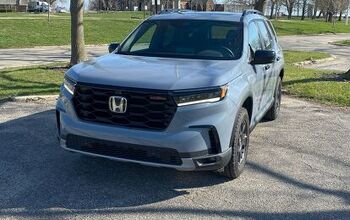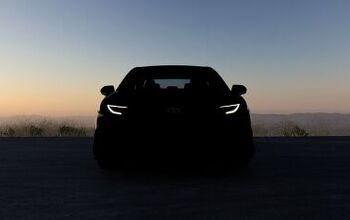Piston Slap: The Life Cycle of Structural Enhancements

Chris writes:
Hi Sajeev,
I’m in the market for a new(er) car to replace my 2005 Nissan Quest. Safety is a very important precondition for my purchase since it will be used to transport my kids around our very congested city. I was thinking about leasing a 2017 model and narrowed my search down to a Chevy Equinox, Nissan Rogue, or Mitsubishi Outlander (all about $200/month for 36 months with $3K down). In crunching the numbers, I quickly realized that with the $10,200 or so that I’d spend on leasing a car that I’d eventually have to part ways with, I could easily buy a low mileage example that was between 3-6 years old.
Looking on Craigslist, I found a nice 2010 Equinox with around 60K miles for $9500. It looks just like the 2017 model.
In doing my research on it, I could not find any data on its performance on the IIHS small overlap crash test, though it earned a rating of “good” for the 2014 model. I contacted the Chevrolet support center for information about any structural enhancements that might have been added after MY’10, but they were no help. So, here’s my question:
Could a new car that was engineered a few years before being tested be counted on to perform equally well as its nearly identical younger brother?
Sajeev answers:
First off, kudos to you for keeping safety in mind. Newer vehicles in general are safer than older ones, but the short answer to your question is a definite maybe.
Long answer: dig into parts interchange reference manuals, looking for part number variances between bumpers, subframes, core supports or any other structural item that bolts to the same body over the life cycle of its design. That’s because safety is sometimes bolted on for higher crash test scores.
Whether the “older” bumpers of the Honda Fit are truly inferior is up for debate: re-designing a part to pass a specific test doesn’t imply overall frontal collision superiority. Not to get on the defensive, but manufacturers do their real-world tests (and computer simulations) before IIHS gets their hands on a production model. Plus, after hearing about fatalities from collisions with trees or head-on impacts with DWI speeders, I reckon lab testing–from any source–has a finite amount of significance in the real world.
While I hesitate to bring up dieselgate in this discussion, I’m still going there: the notion of designing a vehicle to pass a specific test while wholly ignoring the spirit of the exercise comes to mind. Unfair analogy? Opening myself up for a flame war?
I am willing to take my lumps so have at it, Best and Brightest.
[Image: IIHS]
Send your queries to sajeev@thetruthaboutcars.com. Spare no details and ask for a speedy resolution if you’re in a hurry…but be realistic, and use your make/model specific forums instead of TTAC for more timely advice.

More by Sajeev Mehta
Latest Car Reviews
Read moreLatest Product Reviews
Read moreRecent Comments
- Lichtronamo Watch as the non-us based automakers shift more production to Mexico in the future.
- 28-Cars-Later " Electrek recently dug around in Tesla’s online parts catalog and found that the windshield costs a whopping $1,900 to replace.To be fair, that’s around what a Mercedes S-Class or Rivian windshield costs, but the Tesla’s glass is unique because of its shape. It’s also worth noting that most insurance plans have glass replacement options that can make the repair a low- or zero-cost issue. "Now I understand why my insurance is so high despite no claims for years and about 7,500 annual miles between three cars.
- AMcA My theory is that that when the Big 3 gave away the store to the UAW in the last contract, there was a side deal in which the UAW promised to go after the non-organized transplant plants. Even the UAW understands that if the wage differential gets too high it's gonna kill the golden goose.
- MKizzy Why else does range matter? Because in the EV advocate's dream scenario of a post-ICE future, the average multi-car household will find itself with more EVs in their garages and driveways than places to plug them in or the capacity to charge then all at once without significant electrical upgrades. Unless each vehicle has enough range to allow for multiple days without plugging in, fighting over charging access in multi-EV households will be right up there with finances for causes of domestic strife.
- 28-Cars-Later WSJ blurb in Think or Swim:Workers at Volkswagen's Tennessee factory voted to join the United Auto Workers, marking a historic win for the 89- year-old union that is seeking to expand where it has struggled before, with foreign-owned factories in the South.The vote is a breakthrough for the UAW, whose membership has shrunk by about three-quarters since the 1970s, to less than 400,000 workers last year.UAW leaders have hitched their growth ambitions to organizing nonunion auto factories, many of which are in southern states where the Detroit-based labor group has failed several times and antiunion sentiment abounds."People are ready for change," said Kelcey Smith, 48, who has worked in the VW plant's paint shop for about a year, after leaving his job at an Amazon.com warehouse in town. "We look forward to making history and bringing change throughout the entire South." ...Start the clock on a Chattanooga shutdown.


































Comments
Join the conversation
If you're truly interested in safety, I'd recommend a new vehicle for all the electronic safety nannies. Add in the better mpg of new cuvs, and you can easily justify getting the new model from a total cost of ownership point of view. You seem content with rather lacklustre vehicles, so finding a bargain this winter ( if you can wait) should be easy.
Dear OP, If you have the means, just buy the new car and call it a day. If safety is paramount, then anything you buy used/older is a compromise to safety.